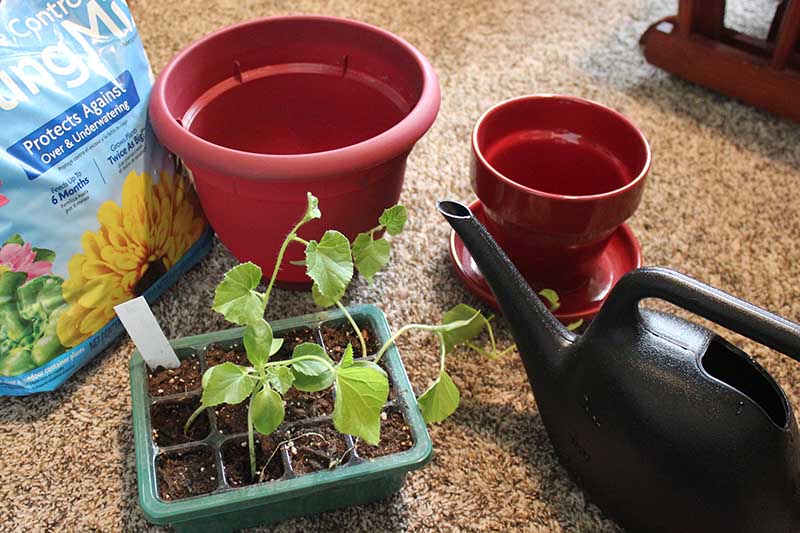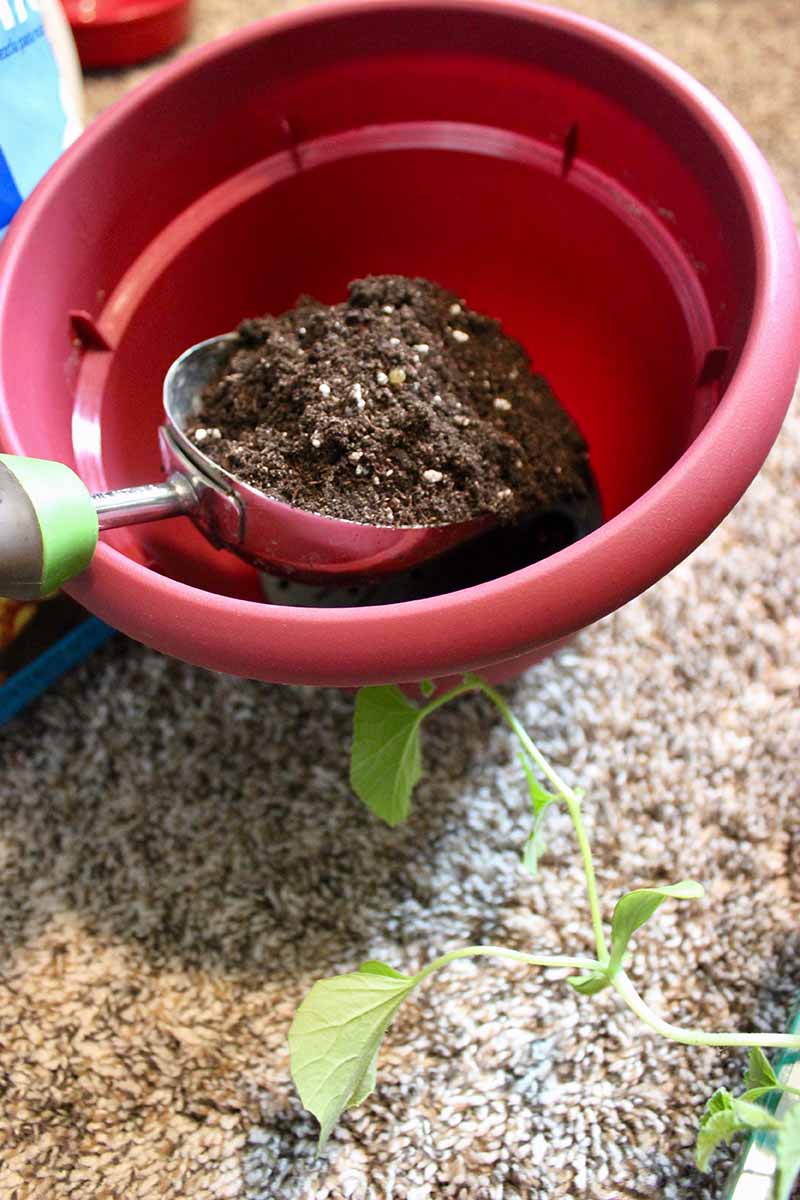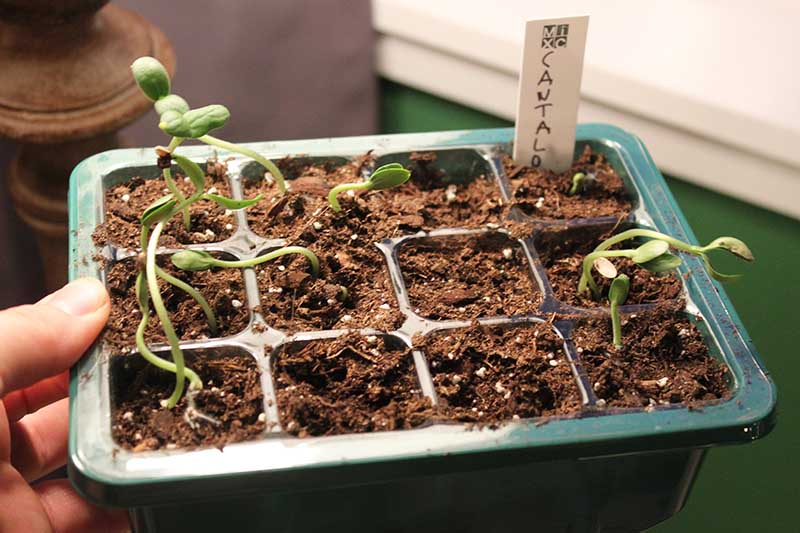Or maybe your garden is already chock-full of green goodness and you don’t have any space for any huge, hungry melons.
Whatever the reason, if you think you don’t have the space to grow your own sweet cantaloupe, think again.
We link to vendors to help you find relevant products. If you buy from one of our links, we may earn a commission.
With the right care, cantaloupe can thrive in a container – even a smallish one – which means anyone, anywhere, in whatever size house or garden, can enjoy its sweet deliciousness.
Originating in south Asia, cultivated in Europe, and sold commercially in the United States since 1890, there are two major varieties we enjoy today: the North American Cucumis melo var. reticulatus, and the European C. melo var. cantalupensis.
To find out more about this best-ever melon (in my opinion!), check out our cantaloupe growing guide.
For a container garden, you’ll need to select a dwarf variety – I’ve provided a couple of recommendations below – and you’ll also need to train them to grow vertically, using a trellis, or a tomato cage.
Growing juicy, sweet cantaloupe (also known as muskmelon) is a rewarding experience for any gardener. But what if you don’t have the space for a large garden plot or raised bed? Not to worry – with the right conditions and care, it’s entirely possible to grow cantaloupe in a container right on your patio or balcony.
Why Grow Cantaloupe in Containers?
There are several advantages to container growing cantaloupe:
-
Lack of space – If you live in an apartment or have a small yard container gardening allows you to grow cantaloupe even without an in-ground garden. The plants can thrive on a balcony, patio or any sunny spot.
-
Portability – Containers are movable, meaning you can place the plants in an optimal spot and move them as needed to follow the sun or protect from weather. This is especially helpful if you need to bring them indoors or under shelter.
-
Extend the season – In cold climates, containers allow you to start plants early indoors or in a greenhouse. You can also move them inside to protect from frost. This extends the growing and harvesting season.
-
Customize care – With containers, it’s easy to control and customize soil quality, irrigation, and fertilization to optimize growth. You can also spot and treat pests/disease quickly.
Choosing a Container and Site
To grow healthy, productive cantaloupe in a container, follow these guidelines:
-
Container type – Use a container at least 16-24 inches wide and deep Sturdy plastic, fabric, terra cotta, wood, or metal all work Ensure there are drainage holes at the bottom.
-
Soil – Use a high-quality potting mix, not garden soil which can be too heavy Cantaloupe prefers slightly acidic soil with a pH of 60-6.5.
-
Site – Cantaloupe needs at least 6-8 hours of full sun daily. Choose a sunny spot on a patio or balcony. If needed, move the container to follow the sunlight.
-
Support – Provide a trellis, cage, or other vertical support structure for the vines to climb. This saves space.
-
Irrigation – Ensure the container has a saucer or tray to hold water and that the soil stays evenly moist but not soaked.
Growing Cantaloupe from Seed
Cantaloupe can be grown from seed directly in the container or started indoors and transplanted:
-
If growing outdoors, sow 2-3 seeds 1/2 inch deep in each container after the soil warms in spring, usually 1-2 weeks after the last expected frost.
-
For a head start, start seeds indoors 3-4 weeks before your outdoor planting date. Sow 1-2 seeds in biodegradable pots.
-
Thin to the strongest seedling per container when the first true leaves appear.
-
Harden off and transplant outdoors when plants have 3-4 true leaves, burying the stem up to the leaves.
-
Pinch off weaker seedlings to allow the strongest one to grow. One plant per large container is sufficient.
Caring for Container Cantaloupe
For optimal growth and fruiting, cantaloupe requires:
-
Water – Keep soil consistently moist but not soaked. Use drip irrigation or water at the base to keep foliage dry.
-
Fertilizer – Use a balanced fertilizer when plants are 4-6 inches tall. Switch to a low-nitrogen fertilizer once flowers appear so energy goes to fruit not leaves.
-
Pollination – Hand pollinate flowers by transferring pollen between flowers with a small brush or cotton swab for best fruit set.
-
Support – As vines grow, gently tie main runners to the support structure. For large fruits, use soft netting to cradle each melon.
-
Pruning – Prune excessive side shoots and leaves to focus growth on the main runners and developing fruits.
-
Sunlight – Ensure plants receive maximum sunlight throughout the day by moving or rotating containers as needed.
-
Insects & disease – Inspect regularly and treat any pests or fungus. Targeted sprays or organic treatments can remedy issues before they spread.
Harvesting Cantaloupe
Cantaloupe typically matures 60-90 days from seeding or transplanting. Signs of ripeness:
-
Rind turns from green to tan or yellow and develops netting
-
Stems separate easily from fruit with a gentle tug
-
Blossom end emits a strong, sweet aroma
-
Fruit feels heavy for its size
Use pruners or a knife to cleanly cut melons from the vine, leaving 1-2 inches of stem. Enjoy immediately or store ripe cantaloupe in the refrigerator for 3-5 days.
Tips for Success with Container Cantaloupe
Follow these tips to maximize your cantaloupe container garden:
-
Select compact, bush-type varieties ideal for containers like Sugar Cube. Avoid long-vining types.
-
Use large containers (at least 24 inches wide and deep) to provide sufficient soil and root space.
-
Move containers to maximize sun exposure and/or provide frost protection as needed.
-
Use trellises, cages, or vertical supports to save space and support vines and fruits.
-
Hand pollinate flowers for best fruit production since insects may not access containers.
-
Consistent moisture is key – check soil and water when the top 1-2 inches become dry.
-
Situate containers near seats or walkways for easy tending and harvesting.
With the right variety, soil, sun, and care cantaloupe can thrive in containers. Just be diligent about monitoring moisture, nutrients, and pest/disease issues since container plants depend fully on your maintenance. In return, you’ll be rewarded with garden-fresh cantaloupe fit for a king!

Choosing the Right Container
These vining plants need plenty of space for their roots to grow, so choose a container that’s at least 16 inches deep and 14 inches wide.
If you have the space, you could try these giant whiskey barrel planters, available from Home Depot, if you want to grow full-size varieties.
Indoor or patio-garden growers may want something smaller and easier to move around. The pot you choose can be made from sturdy plastic, terra cotta, or breathable fabric.
As long as it provides good drainage with holes at the bottom, or a self-watering planter insert, you’re ready to get started.
And you can always add pebbles to the bottom of the container for drainage if needed – and if you’re not planning to move it around.
When I got started with the task of transplanting my young plants from seed trays into containers, I realized that none of the pots I had on hand were truly big enough.

As the plants are still smallish, I decided to transplant them anyway. I’ll move them into their larger, permanent containers in a few weeks.
You can do the same if you’re still trying to locate the ideal planter for your young melons.
Before you get growing, find a full sun location where your container will receive 6-8 hours of sunshine per day.
This can either be a sunny area of your house, under artificial light, or outdoors.
Fill your container to an inch below the top with either:
- Good quality, well-draining potting mix (don’t add fertilizer yet)
- Well-draining garden soil amended with compost or well-rotted manure.
If you decide to use soil from your garden, don’t use soil that has been previously planted with cucurbits, as it can harbor disease.

Cantaloupes prefer soil with a mildly acidic pH of 6.0-6.5, that is loose and well-draining to encourage the growth of healthy roots.
You can either direct sow seeds in your container or start them in seed trays. If you live in a cold area, it’s best to sow seeds indoors at least four weeks before your average last frost date.
For those in warmer areas, sow in containers outdoors anytime after your average last frost date, provided your growing season is long enough to give your chosen variety time to mature.
Since I live in frigid Alaska, I started mine in seed trays a couple of months before last frost. Because I planted them pointy-side-up, only half the seeds germinated. Oops!
You should plant them pointy-side-down, as that’s where the roots emerge.

To sow seeds in containers, dig a half-inch-deep hole and drop two seeds inside, pointy-side-down. Do the same thing in seed cells. Cover with soil, and water with a spray bottle so you don’t displace the seeds.
To encourage them to germinate quickly, you can cover the pot or seed tray with plastic to trap humidity inside.
Just make sure to remove the covering the moment the first green shoot pokes through the soil. Keep them evenly moist, in a sunny spot or under a grow light.
Thin seedlings to one per container or seed cell when they have their first set of true leaves.
If you start your seeds in trays (or have purchased seedlings from the nursery), you’ll need to transplant them to their permanent container when they have at least two sets of true leaves.
I left mine in their trays for two months, and one of the plants started getting droopy and unhappy.
I’m pretty sure it felt cramped, and didn’t have enough root space.

If you are transplanting your seedlings to an outdoor container, make sure you harden them off first.
To do this, place them outside in a sunny location for a few hours per day, gradually increasing the amount of time over the course of a week.
To transplant, all you have to do is dig a hole the size of the root ball, gently remove the seedling from the tray, and set each one in its new container. To make this easier, water the seedlings about half an hour before transplanting.
Backfill the hole, give the seedling a slow, deep watering, and add half an inch of extra soil on top for support.
Then, place the containers near a sunny windowsill, under a grow light, or in your chosen location outdoors.
When the plant is about four to six inches tall, fertilize with a balanced liquid fertilizer such as 5-5-5 (NPK) according to package instructions.
Fertilize again in about two or three weeks, or when flowers start to develop. But this time, use a lower nitrogen fertilizer, such as 5-10-10 (NPK), so you don’t promote too much leafy growth and not enough fruit development.
Another important aspect of keeping cantaloupes happy is to provide adequate water. These plants need consistent moisture, but don’t allow them to become waterlogged.
This is especially important when you’re growing them in containers, which dry out more quickly than garden soil. To help keep the soil moist, you can apply a layer of straw or other mulching material.
Keep the foliage dry by irrigating at the base of the plant, not from overhead.
In the last week before harvest, water only when the top two inches of soil is dry and the leaves are slightly wilted. This allows the sugars to concentrate in the melons and prevents them from cracking.
Training the Vines on a Trellis
Remember how I said not to worry about managing unruly vines in a 16-inch container? Here’s why: it’s easy to train them to grow vertically on a trellis or similar support structure.
Easy supports for container-grown cantaloupes are bamboo u-hoops, like these from the Home Depot.
You can also use tomato cages, or train them up a trellis against a wall in your garden.
To attach the plant, take some garden tape and wrap it around the vine, and tie it to the hoop or trellis. Add more tape to attach new growth to the structure as the vines get longer.
When the melons have grown to about the size of a fist, you can use ankle-length nylons or netted produce bags to sling the fruit to the structure, to give the vine extra support.
Simply place the produce bag around the developing fruit, and attach it to the trellis or other support. As the fruit grows, the bag will expand and prevent the vine from breaking.
- Choose a container that’s at least 16 inches deep and 14 inches wide
- Maintain even moisture until the last week before harvest, then reduce watering to only when dry
- Train vines to grow vertically on a trellis to save even more space
While you can grow full-size melons in containers, you’ll get the best results with dwarf cultivars that produce smaller fruits and shorter vines.
Here are a couple of my favorites:
True to its name, ‘Sugar Cube’ delivers sweet flavor. It is resistant to many common diseases, including fusarium wilt.
This hybrid cultivar produces small fruits of just 2-4 pounds in weight, so it’s ideal for container growing.
Like other melons, ‘Sugar Cube’ needs full sun, and fruits will be ready to harvest in 80 days.
Find packets of 30 seeds available at Burpee.
This “baby” melon reaches about 2 pounds in weight, with a firm flesh and sweet flavor.
You can even store these babies in the refrigerator for up to two weeks before cutting, and they’ll stay fresh.
Hailing from Italy, ‘Tuscanito’ is a popular hybrid to wrap in prosciutto for a tasty snack.
With plenty of sunshine, you can njoy your ‘Tuscanito’ fruit in just 70 days.
You can find seeds in a variety of packet sizes at True Leaf Market.Want more selections? Find them in our follow up guide:
BEST TIPS for growing CANTALOUPE: Grow SWEET, FLAVORFUL cantaloupe with these tips.
FAQ
Does cantaloupe grow well in containers?
Select the Ideal Variety: Some melon varieties are better suited for container gardening than others. Compact or bush-type melon varieties are excellent choices. Consider “Sugar Cube” or “Minnesota Midget” varieties for cantaloupe and opt for “Sugar Baby” or “Little Darling” when selecting your watermelon.
Is it better to grow cantaloupe on the ground or trellis?
Wire fencing works well. Trellising offers several advantages: Vines get better air circulation than on the ground, which reduces the chances of disease. In northern zones, vines also get more sunlight when on a trellis that’s positioned at a slant toward the sun.
How many cantaloupes can you get off of one plant?
I’ve read that cantaloupe plants “can” support anywhere from 2-8 melons. One source I read said to prune off all but one total melon at a time, to concentrate the sugars into the melon for extra tasty fruit. Others said that as long as there’s only one melon per vine, 2-3 total per plant is fine.
